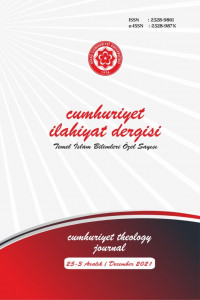Kur’an-Sünnet Bütünlüğü Bağlamında Kur’an Yolu Tefsirinde Hadis Kullanımında Görülen Problemler
The Problems in Ḥadīth Usage in Kur’an Yolu Tafsīr within the Context of Qurʾān-Sunnah Unity
Author(s): Mehmet Ali ÇalganSubject(s): Semiotics / Semiology, Islam studies, Semantics, Philosophy of Religion, Hermeneutics, Qur’anic studies
Published by: Cumhuriyet Üniversitesi İlahyat Fakültesi
Keywords: Ḥadīth; Qurʾān; Tafsīr; Sunnah; Kur’an Yolu;
Summary/Abstract: The Sunnah has an important role in the correct understanding and the protection from wrong interpretations of the Qurʾān. Accordingly, ḥadīth played a crucial role in shaping the opinions of the mufassirs. In this article, the tafsir titled Kur’an Yolu written by a group of scholars and first published by the Presidency of the Religious Affairs in 2003 which is widely read in Turkey is examined from ḥadīth usage point of view. The problems in ḥadīth usage are classified under headings such as insufficiency/incorrectness in the explanation of verses due to insufficient usage of ḥadīth, not including ḥadīth which corroborate the verse, wrong conclusions derived from ḥadīth, problems with citations, ḥadīth translation problems, wrong explanation of ḥadīth, problems with some issues related to Sunnah. Over fifty examples where there were wrong citations of ḥadīth, wrong conclusions were derived, there was mixing up of ḥadīth and translation errors leading to wrong meanings were determined and the most important ones were studied. Due to these problems regarding ḥadīth usage, it was seen that sometimes the unity of Qurʾān and Sunnah was violated and some wrong explanations were given. The article is important due to determination of these mistakes and attracting attention to care and precaution in ḥadīth usage in this kind of works. This study indicates the importance of Qurʾān-Sunnah unity and shows the important role that ḥadīths play in understanding the verses. It is observed that in case hadiths related to a verse are not given or given in an insufficient or incorrect manner the verse in question is understood or interpreted incorrectly. Therefore, the correct translation and explanation of the ḥadīth, avoiding citation mistakes and making use of primary sources are very important. The factors that lead to wrong conclusions are not evaluating a ḥadīth in its entirety (taking into account only the first part of the ḥadīth), not evaluating the ḥadīths related to a subject in entirety (taking into account only certain ḥadīths), not making use of commentaries in order to understand a ḥadīth correctly and wrong citation of a ḥadīth. The fact that the ḥadīth which is about the gladness of Allah due to the repentance of a person has been confused with another ḥadīth and an additional error has been made in the text of this ḥadīth indicates that the authors have remembered this ḥadīth incorrectly and they have not verified this ḥadīth in its source. Given the material mistakes in many other examples under the citation errors title, it has been concluded that the wrong citation of ḥadīths in a way that affects the meaning constitutes a serious problem for the work under examination. As to the translation problems, it is observed that they arise from wrong citation of the ḥadīth from its sources (for instance omitting a word or adding expressions that are not found in the ḥadīth) or not making use of commentaries in understanding the ḥadīth. It is necessary that for the analysis of the ḥadīth the authors make use of the tafsir of Ibn Kathīr who is a ḥadīth scholar along with the works of other scholars who are not specialized in ḥadīth in order to correctly determine the accuracy level and meaning of the ḥadīth. It seems necessary that a commission that includes ḥadīth scholars review this work in order to correct the mistakes that are found and to make use of the suggestions that are put forward. This step is important for correcting the mistakes found in this prestigious and widely used work. Furthermore, since many readers gain knowledge about Qurʾān using this work, consideration of issues raised in this study will contribute to the forthcoming edition of the work. It is surprising that despite proposed corrections since its initial publication, so many material mistakes still exist in this valuable work which is a product of great effort. It is hoped that it will continue to become useful for people by making necessary corrections.
Journal: Cumhuriyet İlahiyat Dergisi
- Issue Year: 25/2021
- Issue No: 3
- Page Range: 1277-1298
- Page Count: 22
- Language: Turkish

